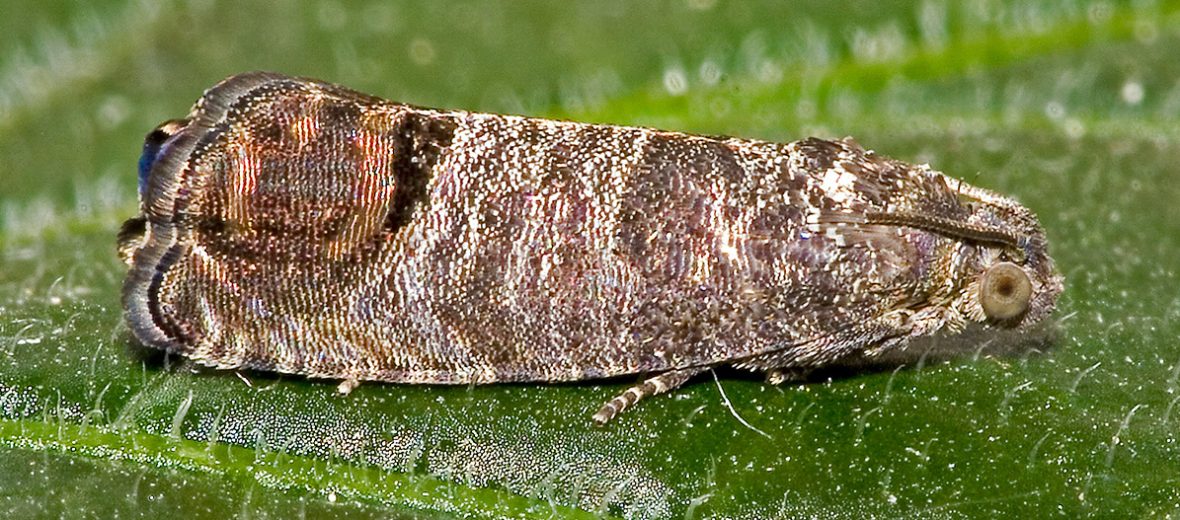
The codling moth is a major agricultural pest that originally hails from Europe. These pest insects destroy various crops and cost the agricultural industry over $550 million annually; and that’s just in the state of Washington! This moth species is considered invasive and dealt with harshly. Seeing as they are abundant and invasive, they are not currently evaluated by the IUCN.
First the Stats…
Scientific name: Cydia pomonella
Length: Up to .39 inch
Wingspan: Up to .78 inch
Lifespan: Up to 38 days
Now on to the Facts!
1.) The codling moth caterpillars bore into fruit and stop it from growing, which then leads to premature ripening. And the fruit is also not salable and must be discarded.
2.) These moths are a global nuisance. They are found on every continent, sans Antarctica.
3.) It is unclear as to whether or not these moths were accidentally distributed by humans.
4.) Temperature decreases only seem to slow down these moths. As when the temps drop to 32°F and below, the larvae seem to stop moving. But when the temps rise again, they awaken from their sleep and continue their devastating reign of terror on the world’s fruit crops.
5.) Due to the fact that these moths are polyphagous (able to eat multiple food types), they are not restricted to a single type of fruit.
But wait, there’s more on the codling moth!
6.) They can be found on apple, apricot, cherry, chestnut, pear, plum, and even walnut trees.
7.) The caterpillars and adult moths are photopositive (attracted to and move towards light).
Did you know…?
The larvae bore into a nearby fruit within 24 hours of hatching from their egg.
8.) It only takes up to 45 minutes to bore into a fruit.
9.) Once the fruit has been penetrated, it begins to ripen prematurely. So, the caterpillar gains beneficial resources, like fat and albumin.
10.) The larvae can feed on a single fruit for up to 27 days. Sometimes, multiple fruits are feasted upon.
But wait, there’s still more on the codling moth!
11.) In a cool adaptation or evolutionary trait, many fruits attacked by the codling moth larvae have developed methods of fighting off the caterpillars. These methods include thickening of the fruit’s epidermis, using stony cells to protect the seed, and developing fuzziness of the fruit to deter codling moth caterpillars from being able to penetrate it.
12.) The number of annual generations varies depending on the climatic conditions. Colder climates produce fewer generations and warmer climates produce more.
13.) These moths can begin reproducing as soon as they reach eclosion (pupate into adults).
Did you know…?
Various methods of control have been used such as, but not limited to: pesticides and mechanical control.
14.) Females lay up to and sometimes over 100 eggs.
15.) Eggs are typically laid near the ends of branches, as that is typically where the fruit will develop.
But wait, there’s still a little more on the codling moth!
16.) Eggs take up to 12 days to hatch, but if the temps are optimal, they can hatch in as little as 5 days.
17.) Predators of these pests include: primarily birds, like woodpeckers, but also spiders, harvestmen, beetles, earwigs, ants, and big-eyed bugs.
18.) These moths are parasitized by different species of wasps, in various life stages.
Did you know…?
Unfortunately, evolution and adaptation have reared generations of insecticide-resistant strains of codling moths. This has made it even more difficult to control their spread and subsequent damage.
19.) There is also a parasitic fungi, called Beauveria bassiana, that attacks codlings.
20.) The antennae of the moths are used to detect fruit.
Now a Short Codling Moth Video!
Be sure to share & comment below! Also, check out the Critter Science YouTube channel. Videos added regularly!
Want to suggest a critter for me to write about? Let me know here.




Leave a Reply